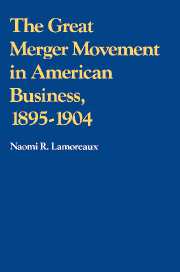Book contents
- Frontmatter
- Contents
- Acknowledgments
- List of tables and figures
- 1 Introduction
- 2 Product differentiation, mass production, and the urge to merge: competitive strategies and collusion in the late nineteenth century
- 3 High fixed costs and rapid expansion: a model of price warfare and two examples
- 4 Quantitative and qualitative evidence on the great merger movement
- 5 What changed? The impact of consolidations on competitive behavior
- 6 The great merger movement and antitrust policy
- 7 Conclusion
- Bibliographical essay
- Index
2 - Product differentiation, mass production, and the urge to merge: competitive strategies and collusion in the late nineteenth century
Published online by Cambridge University Press: 01 April 2010
- Frontmatter
- Contents
- Acknowledgments
- List of tables and figures
- 1 Introduction
- 2 Product differentiation, mass production, and the urge to merge: competitive strategies and collusion in the late nineteenth century
- 3 High fixed costs and rapid expansion: a model of price warfare and two examples
- 4 Quantitative and qualitative evidence on the great merger movement
- 5 What changed? The impact of consolidations on competitive behavior
- 6 The great merger movement and antitrust policy
- 7 Conclusion
- Bibliographical essay
- Index
Summary
In early 1896, competition among domestic manufacturers of tin plate sent prices tumbling below the level at which plates could be imported into the country. That April the manufacturers met under the aegis of the Tin Plate Manufacturers’ Association to fix prices just below the import level. All but two of the firms in the industry signed the resulting “gentlemen's agreement” (and even one of those promised to abide by it), but by May reports of violations had already proliferated. To make matters worse, in August the industry's largest producer, the American Tin Plate Company (of Indiana), resigned from the association, in effect nullifying the agreement. The other members of the association attempted in November to revive the pact without the participation of this company, but met with only temporary success: “the temptation to do a larger business at lower prices was too great.” In December they determined to alter their strategy. Because the American Tin Plate Company was still operating independently, “it was decided that the other Indiana mills should be recognized as free to make their own market in their own territory, with the understanding that the combination prices be maintained in the East and other sections.” By the end of January this effort, too, had collapsed. Finally, in March 1897, after much urging by the other manufacturers, the American Tin Plate Company consented to join a new Association of Tin Plate Makers of the United States, with its own Daniel G. Reid as chairman. Still nothing availed to stem the competition and the downward slide in prices.
- Type
- Chapter
- Information
- Publisher: Cambridge University PressPrint publication year: 1985



